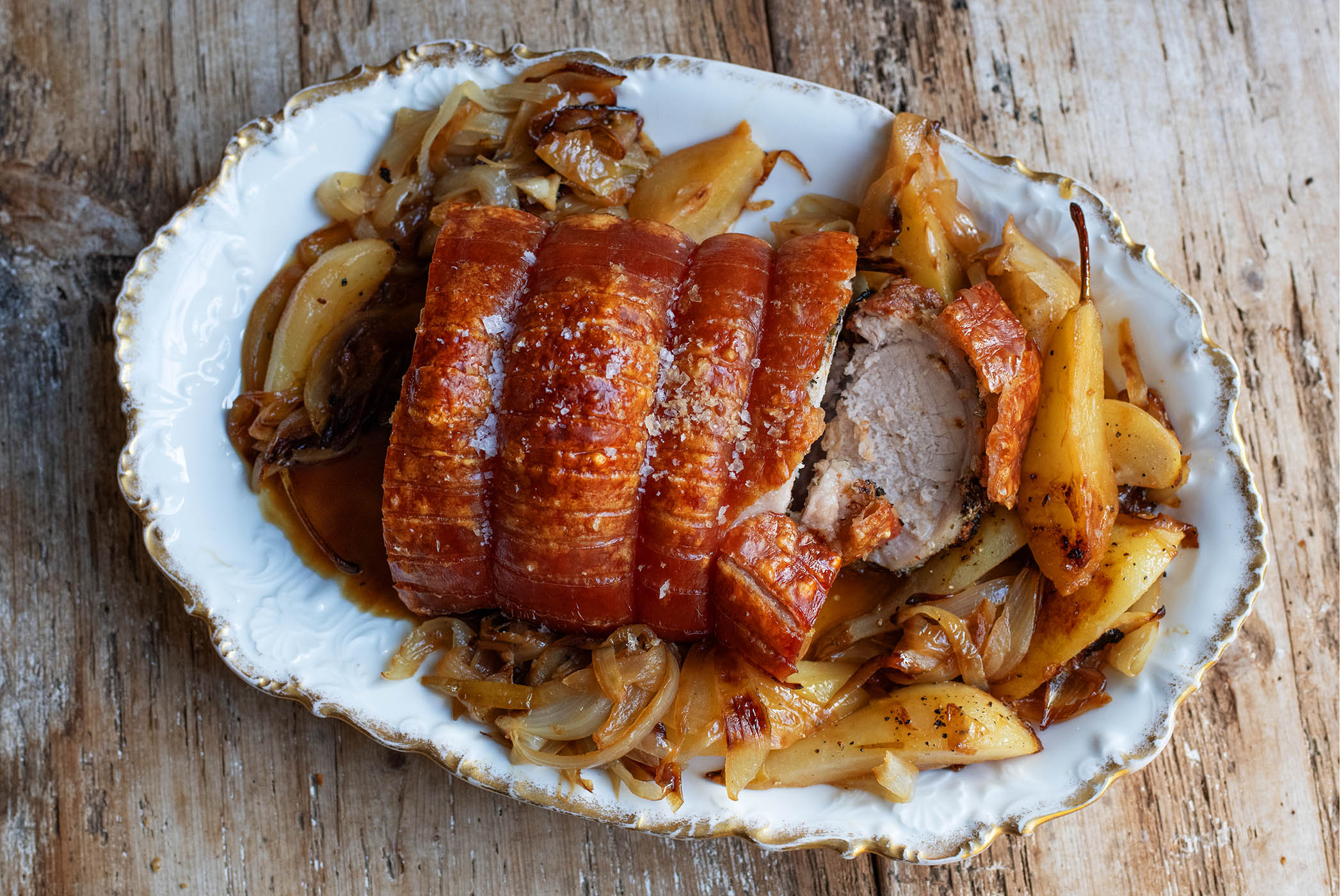The last pears in the garden finally ripened, great golden fruits that hung like Christmas baubles from the branches of my espaliered tree. Frustratingly, on the day before I was due to pick them, my fruits mysteriously disappeared in a night-time raid. I’m looking at the squirrels, but who knows? I hope the culprits enjoyed their midnight feast.
If pears have their moment, it is now, in late autumn, when the rounded Doyenne de Comice are at their best, before their flesh turns grainy. Time for slimmer Conference, too, the pears that crunch beneath your teeth, with rough green skin and ice-white interior. Left to ripen fully, they lack the copious juice of a Comice or a Williams pear, but are still good with cheese. A pear and a piece of parmesan is an elegant way to end lunch.
The pear was one of the first trees I planted in my garden, tying the young branches to a frame of wires along the wall outside the kitchen. Each spring it is a feast of blossom and bees, situated close to the kitchen, so I watch the ripeness of the pears each autumn. But to catch a pear at its moment of perfection involves careful observation. A ripe fruit can go over in what seems like a matter of hours. One minute sweet, honeyed, softly yielding flesh, the next it has collapsed into a purée.
Pears are one fruit that will ripen after harvesting, so I usually keep a few in the dish on the kitchen table so that, as with avocados, I can monitor their progress with a respectful daily squeeze.
This is the time of year for big roasts. Salty, golden crackling that shatters like glass, glowing roasting juices with a note of marsala, sherry or red wine; best of all, the treasure of cold cuts the following day, thin slices of meat to eat with pickles and rustling sautéed potatoes.
This week it was a loin of pork in the oven, boned and spread with a paste of rosemary, juniper berries and salt, before being rolled and roasted.
I will be roasting pumpkins until the end of the year. The real star this week was one roasted with a butter spiced with za’atar and a little sumac. The sourness of the latter a contrast for the sweetness of the squash. We ate the melting, buttery flesh with steamed brown rice.
I had planned to make pots of sherry-hued jelly with the massive harvest from the medlar tree. Sadly I returned after a few days away to find they had suffered in the wind and rain. I swept their brown slush from the garden paths. I now have a compost heap that smells of sour wine.
There have been some extraordinary signs of life in the garden. The fennel that suffered in the summer’s extreme heat is showing bushy tufts of new growth and the rosemary is a mass of tiny buds. When they open I will use the flowers to scent soft, fresh goat’s cheese to eat with sweet walnuts cracked from their shell. Or perhaps I’ll add the nuts, roughly chopped, to a homemade loaf with golden sultanas and the merest trickle of honey.
Roast loin of pork
Serves 6. Ready in 2 hours.
I ask my butcher to bone the loin for me, but to leave it unrolled, so it is easy to apply the herb paste. Then I roll it as best I can and tie it in three or four places with string. Use a large roasting tin with plenty of space around the roast for the onions and pears. If you don’t have one large enough, roast the onions and pears in a separate tin. You can use unsweetened apple juice in place of the cider or perry.
rosemary leaves 2 tbsp
juniper berries 8
black peppercorns 1 tsp
olive oil (or pork dripping) 4 tbsp
boned loin of pork roughly 1.5kg, skin and fat scored
onions 2
pears 4
perry or cider 250ml
Heat the oven to 220C/gas mark 7. Finely chop the rosemary leaves, then grind them together with the sea salt, juniper berries and peppercorns, to a coarse sand-like mixture. Pour in 3 tbsp of the olive oil to make a paste.
Put the pork loin in a large roasting tin, then rub the seasoning into the flesh with your fingers or the back of a spoon. Roll the pork up and secure into a tight roll with butchers’ string. Rub the skin with a little salt, then roast in the preheated oven for 25 minutes until the skin has started to puff up.
Reduce the temperature to 200C/gas mark 6 and continue cooking for 25 minutes per 500g (for a 1.5kg piece of meat that will be 75 minutes).
While the pork is roasting, peel and roughly slice the onions. Let them cook in the remaining oil in a shallow pan until soft and pale gold.
Peel, core and quarter the pears, then add, with the softened onions, to the roasting tin after the pork has been cooking at the lower temperature for 30 minutes, basting with any roasting juices from the pan.
When the pork is ready, remove from the oven and leave to rest in a warm place, loosely covered with foil. Put the roasting tin over a moderate heat, add the perry or cider and let the juices bubble until they are reduced to 200ml. They won’t thicken, you just want to concentrate the flavour.
Carve the roasted pork loin into thin slices and serve with the pear and onion gravy.

